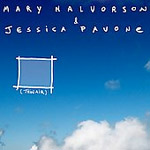|
|
 |
Dusted Reviews
Artist: Mary Halvorson & Jessica Pavone Album: Thin Air Label: Thirsty Ear Review date: Mar. 18, 2009 |

|
|
|
 |
Since its inception in 2000, Thirsty Ear’s Blue Series has tried to expand the boundaries of what it means to be jazz. Their most common forays to the outer limits have attempted to merge jazz with the sounds and syntaxes of hip hop and electronica, which has failed just as often as it’s succeeded. And those failures are more often the result of faulty conceptions than shoddy playing; the Blue Series has managed to have a stable of players matching only AUM Fidelity in terms of versatility and virtuosity. As a result, their “acoustic” releases have been amongst the best to come out this decade. But I digress. What the Blue Series hasn’t really done is explore other potential boundaries of jazz – they haven’t really thought much beyond how programming and beats could change jazz. This album changes that.
Guitarist Mary Halvorson and violist Jessica Pavone are both veterans of Anthony Braxton’s recent bands, both reside in Brooklyn, both compose, and both play regularly in the New York free jazz/free improv scene, so it’s unsurprising that these two would be sympathetic. As a jazz ensemble, the viola/guitar duo isn’t entirely without precedent, though it is fairly rare. The only ensemble to really come close was the String Trio of New York, which filled out the trio with a bass. They explored the outer reaches of jazz, but not in the way that Halvorson and Pavone do.
Essentially, the two of them have found the space between free jazz, free improv and free folk. They explored, to some extent, the same space in their first two albums, but this disc takes them even farther than before. Their compositions tend to be rooted in folk-like melodies, presented either in a beautiful, pseudo-naïve way with the bare melodies in the viola accompanied by plaintive figuration in the guitar, or in a slightly more sinister, Spires That in the Sunset Rise-style fractured orchestration, complete with oddly placed dissonances and driving underlying rhythms. Pavone often does her best Leroy Jenkins impression, playing out of tune in just the right places, knowing just when to make things more abstract. Oh, and the two of them also sing on a couple songs, their close harmonies heightening either of those moods, but generally they sing with an unadorned, unemotive deadpan.
These folksy melodies rapidly degrade, interrupted by bursts of noise, Derek Bailey-esque guitar splatter and John Cale-esque viola scratching. Halverson is especially good at this, switching from straightforward rhythmic accompaniment to heavily distorted squalls to folksy solos to turntable-like effects with ease. All of this is encapsulated in the title track, which starts off with a folksy/naïve groove in the guitar and viola under equally folksy/naïve vocals with just enough odd chords thrown in to upset the balance, causing the song to constantly spin off into free splatter. But it always finds a way to regroup for a new verse, with the pattern repeating in different ways each time through the cycle with the drama increasing each time through.
So where is the jazz in all of this? Is it in the improvisation? Or the folk appropriation (remembering that Charles Mingus insisted on changing the Impulse motto to “The new wave of folk on Impulse!” for The Black Saint and the Sinner Lady)? Or in their approach to picking apart melodies? It’s hard to actually say for sure, and it is, quite frankly, not really that important. Too much time and breath is wasted on what music is or isn’t jazz, and I don’t want to wade into all the politics of such a pronouncement. And, really, the politics of claiming jazz as a string ensemble is sufficient in and of itself, so it’s almost expected that they’re going to push the boundaries. And Halvorson and Pavone do quite well at pushing, making an excellent case for why genre distinctions are themselves meaningless. Which makes this, I suppose, the perfect manifesto for what the Blue Series is ideally about.
By Dan Ruccia
|







